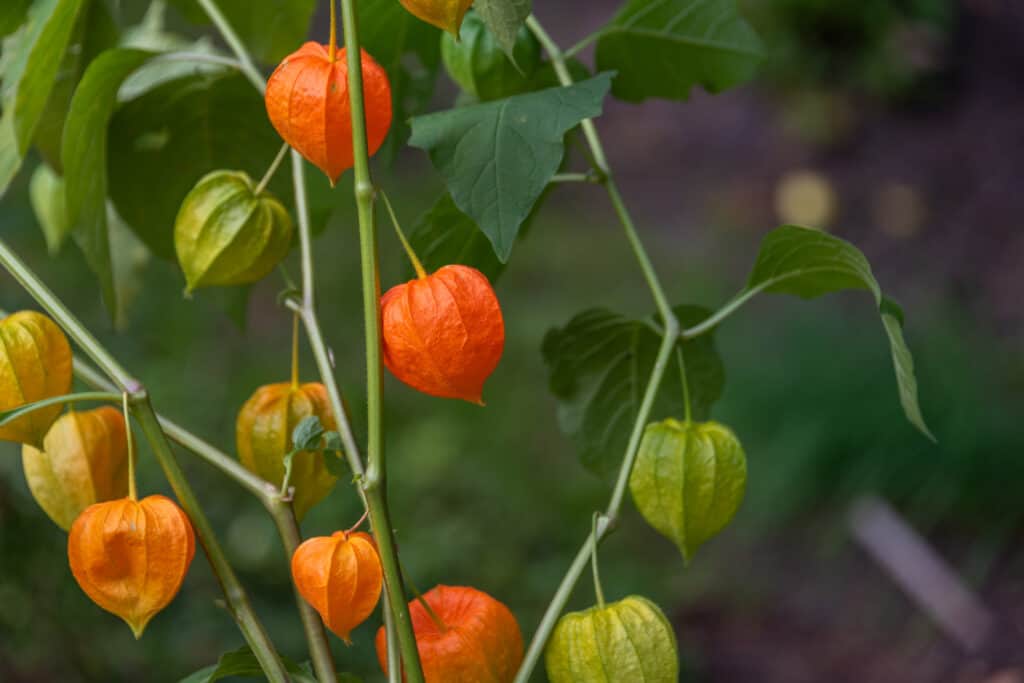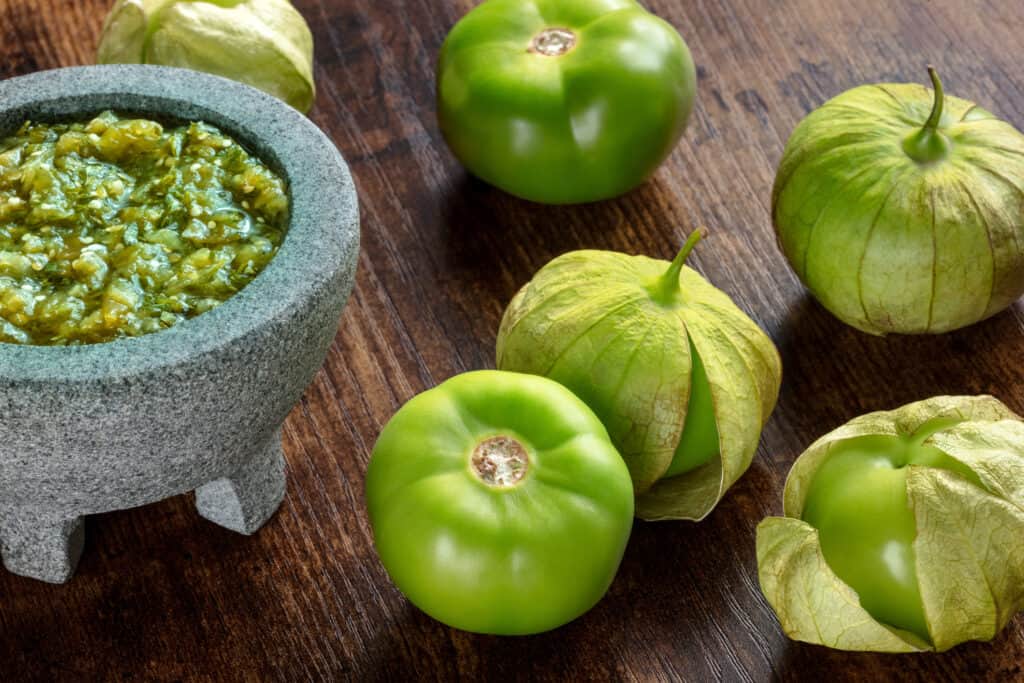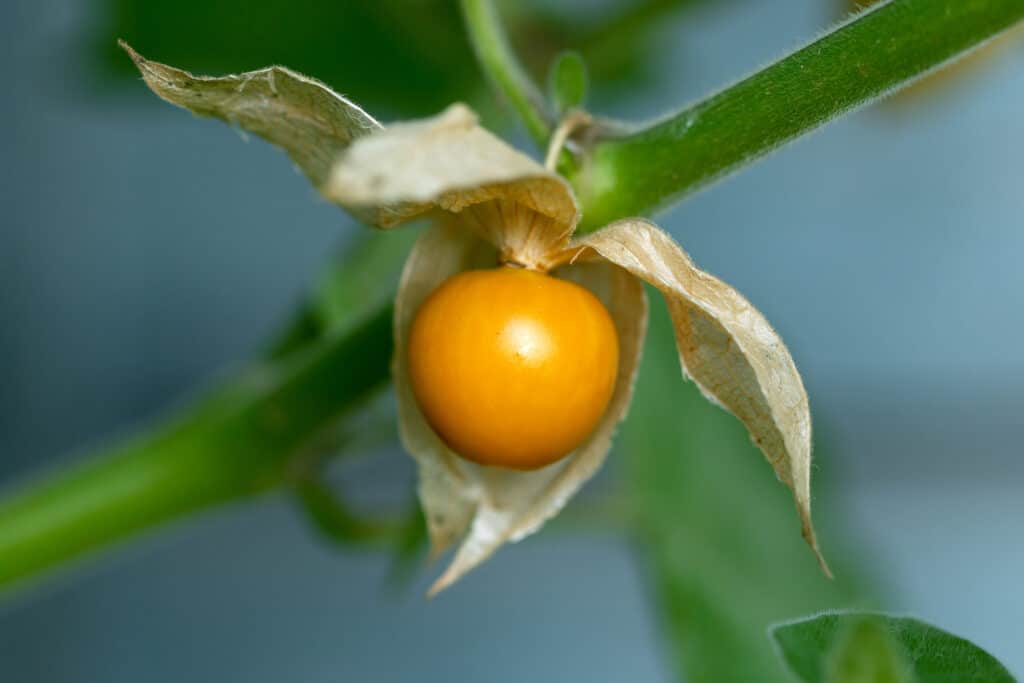Ground cherries and tomatillos are both little-known flowering plants that produce succulent fruits that are a great addition to any kitchen. They both have a similar, sprawling style of growth, and their fruit develops in papery husks. But just how alike are they really? Let’s discover everything you need to know about ground cherry vs. tomatillo!
Comparing Tomatillo vs. Ground Cherry
| Tomatillo | Ground Cherry | |
|---|---|---|
| Classification | Physalis philadelphica | Physalis (genus) |
| Alternative Names | Mexican husk tomato, husk tomatoes, Mexican groundcherry | Husk tomatoes, husk cherries, poha berries, golden berries |
| Origin | Central America, Mexico | The Americas |
| Plant Height | 3 – 4 feet | 2 – 3 feet |
| Leaves | Serrated | Velvety, purple veins |
| Flowers | Yellow, 5 petals | White to yellow, bell-shaped, purple centers |
| Fruit Size | 1 to 2 inches | 0.5 inch |
| Fruit Color | Green, greenish-purple, yellow | Red, orange |
| Ripe | When the husk is filled | When the husk is dried |
| Taste | Tart-like | Sweet, slightly tropical |
The Key Differences Between Ground Cherry and Tomatillo
The main differences between ground cherry and tomatillo are the size of the plant and the size and color of the fruit. Tomatillo plants are larger than ground cherries, and so is their fruit. The other differences between the two include the appearance of their leaves and flowers and the taste of the fruit.
Ground Cherry vs. Tomatillo: Classification

Tomatillo is a species in the genus Physalis and a member of the Solanaceae family group.
©iStock.com/Marti157900
The tomatillo is the species Physalis philadelphica, native to Central America and Mexico. It is a species in the genus Physalis and a member of the Solanaceae family group. Solanaceae is better known as the nightshade family and is a group of flowering plants. Although many of its members are used as food – such as potatoes, tomatoes, eggplant, and peppers – some of its other members are highly toxic. This is because they contain strong alkaloids, and the best known deadly member of the family is the deadly nightshade, also known as belladonna.
Unlike the tomatillo, ground cherries are not actually a single species. Instead, they are the common name given to members of the Physalis genus (which includes tomatillos). There are approximately 75 to 90 different species in Physalis, and they are native to the Americas. Approximately 46 species are endemic to Mexico alone.
Ground Cherry vs. Tomatillo: Size
Another major difference between these plants is that tomatillos are generally much bigger than ground cherry plants. Tomatillos are bushy plants that stand 3 to 4 feet tall and spread to a similar width. Ground cherry plants are also spreading plants with a bushy appearance. However, typically most species do not grow as tall as tomatillos – growing only to a height of 2 to 3 feet.
Ground Cherry vs. Tomatillo: Leaves

Most ground cherries have slightly hairy leaves.
©iStock.com/Andrey Nikitin
Tomatillos have ovate leaves that are significantly narrower at the base than at the end. They have heavily serrated edges and are often described as looking like those of an eggplant.
Most ground cherries have slightly hairy leaves, which have a velvety texture. Their leaves are usually purple-veined, which gives their spreading branches a purplish appearance.
Ground Cherry vs. Tomatillo: Flowers
Both ground cherries and tomatillos produce small flowers, although they look different. Tomatillos produce yellow flowers, which have five petals and dark brown to purple centers.
Ground cherries produce small white or yellow flowers (depending on the species). These flowers are typically bell-shaped and have dark purple centers.
Ground Cherry vs. Tomatillo: Fruit

Tomatillos are typically green when ripe.
©iStock.com/Plateresca
Easily the most noticeable difference between ground cherries and tomatillos is the appearance of their fruit. Just like the plants themselves, the fruits of tomatillo plants are larger than those of other ground cherry species. Tomatillo fruits have a diameter of 1 to 2 inches, and when ripe, they are typically green, although they can also be greenish-purple or yellow.
Although tomatillos technically come under the same umbrellas as ground cherries, the fruits from most ground cherries in Physalis are a brilliant red or orange color. They also usually have a diameter of around 0.5 inches.
Ground Cherry vs. Tomatillo: Ripe

When ground cherries are ripe, the husk dries up and breaks down, leaving a delicate case around the fruit.
©iStock.com/Maksims Grigorjevs
Both ground cherries and tomatillos continue to flower and bear fruit until the frost kills them. However, they actually take on a different appearance when they are ripe. The fruit of both plants develops in a papery husk. When tomatillos are ripe, the fruit fills out the entire husk, which then splits open to reveal the fruit. However, when ground cherries are ripe, the husk dries up and breaks down, leaving a delicate case around the fruit.
Up Next:
- Turnip Greens vs. Collard Greens
- Celebrity Tomato vs. Early Girl Tomato
- Ground Cherry vs Gooseberry: What’s the Difference?
The photo featured at the top of this post is ©
Sources
- Ask Any Difference, Available here: https://askanydifference.com/difference-between-tomatillo-and-ground-cherry/
- Small Kitchen Guide, Available here: https://smallkitchenguide.com/tomatillo-vs-ground-cherry-whats-the-difference/
- The Spruce, Available here: https://www.thespruce.com/how-to-grow-organic-ground-cherries-2539577
- The Spruce, Available here: https://www.thespruce.com/growing-tomatillos-in-the-vegetable-garden-1403467
- Gardeners Path, Available here: https://gardenerspath.com/plants/fruit/grow-ground-cherries/
FAQs (Frequently Asked Questions)
Are ground cherries actually cherries?
No, despite their name, ground cherries are not actually cherries, nor are they closely related to them. Cherries are generally described as the fruit from members of the Prunus genus.
Are tomatillos and ground cherries easy to grow?
Yes, both plants are easy to grow. Tomatillos grow best in full sun and for the best results they should be started indoors and then transferred outdoors after the last frost. Ground cherries grow well in gardens or raised garden beds so long as they have plenty of sun and well-drained soil. They can either be started indoors or you can wait until after the final frost to start them outdoors.
How much space do ground cherries and tomatillos need?
Both plants are bushy and have a tendency to spread wide across the ground. Therefore, for the best results you should plant ground cherries at least 2 feet apart. As tomatillos are larger than ground cherries you should allow around 3 feet of space between them when planting.
What are tomatillos and ground cherries best used for?
With the sweet and slightly tropical taste of ground cherries and the slightly tarty taste of tomatillos, they both have a wide variety of uses when it comes to cooking. Tomatillos are perfect for salsas and salads, but if you want their flavour to become more mellow then they are a great addition to stews. Ground cherries are also used in salads and salsas, but they are also great in jams and are a popular garnish for deserts.
Are tomatillos and ground cherries perennial or annual?
Both tomatillos and ground cherries are perennial plants which means that they live for longer than two years. However, in many cases they (but especially tomatillos) are grown as annuals every year – particularly amongst commercial food producers.
Thank you for reading! Have some feedback for us? Contact the AZ Animals editorial team.






